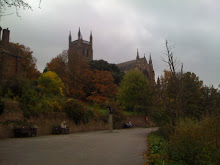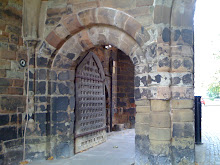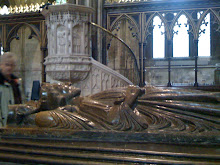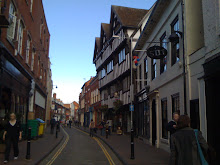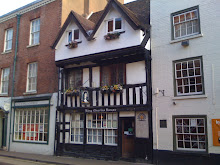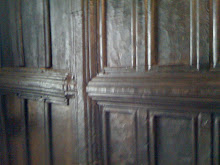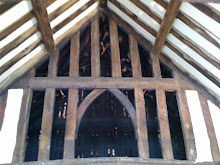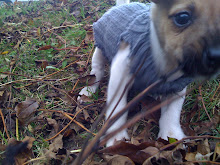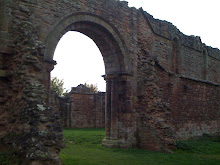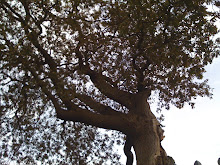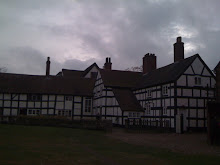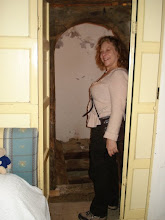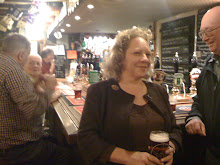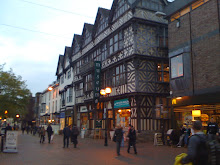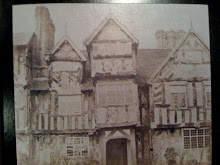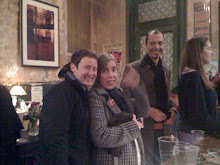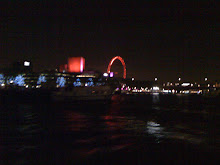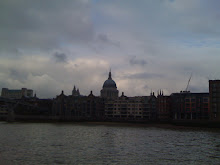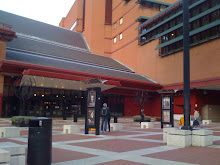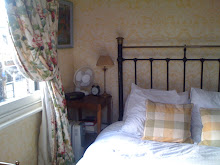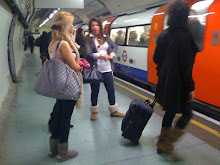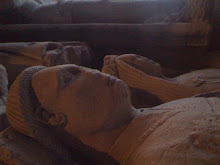Thursday, December 31, 2009
Running Into Charles at the Airport
I fell sadly behind on blogging in my last few days in England - the research adventures were piling up thick and fast, and it was hard to find the time to record what I was doing. I will get caught up, soon. But I will leave 2009 by reporting this little tidbit: when I flew home on November 11, who should be down the counter checking into the same flight but Rufus Sewell, who, among other things, did a really good job playing Charles II in the British miniseries "Charles II: The Power and the Passion." I made so bold as to accost him and tell him I was a big fan of his work, particularly his portrayal of Charles. I gave him my card, and he grinned and said, "The Darling Strumpet! I'll have to find that!" So if you're seeing this, Mr. Sewell, thanks! You made my day!
Sunday, November 8, 2009
Grey's Inn, Wilton's Music Hall, Bonfire Night
Grey's Inn Hall
On Friday my friend Clare, who is a barrister, took me to lunch at Grey's Inn Hall . Grey's Inn, Lincoln's Inn, The Middle Temple, and the Inner Temple are the centuries-old law schools of England, where many barristers still have their chambers. Grey's Inn Hall is beautiful - hammer beam roof, dark and elaborately carved wood paneling, stained glass windows, etc. And rich with history. Besides its legal history, it was the site of early performances of some of Shakespeare's plays. No pictures were permitted, but you can see a photo of the interior at http://www.greysinn.info/ and learn more about Grey's Inn at http://en.wikipedia.org/wiki/Greys_Inn.
Wilton's Music Hall
Friday night I met some friends at Wilton's Music Hall (wiltons.org.uk and wiltonsthevenue.co.uk), an 1858 music hall that fell into disrepair and was long closed, used for non-performance purposes, and on the brink of destruction before it was recently saved and restored, and is once again presenting occasional performances. It's near Cable Street in Shadwell, an area of the East End of London near the river that was long associated with sailors and maritime life in general.
Music hall, if you don't know, was the English precursor to American vaudeville, with variety acts, singers and dancers - the working classes' entertainment that thrived during the Victorian era and even into the about the first quarter of the 20th century (http://en.wikipedia/wiki/music_hall)
Friday was a free film night, with screenings of some rather silly Rank Organization special short features from the 1960s on Piccadilly, London's clubs, London's markets, etc. Amazing to see the changes in many areas of London since then. And a big laugh at the chipper line "The London of the future will have no traffic jams!"
The Wilton's building is fantastic, with history oozing from every pore, as my friend Alice says. We sat in the balcony, which runs around three sides of the house, with a narrow rectangular stalls section below, and a proscenium stage with two levels. Beautiful twisting columns, ornate plaster work, all in a state of arrested decay and semi-restoration.
Part of the pleasure of the evening was just being in the place. Before the films we had some snacks and drinks in the Mahogany Bar, which according to the Wilton's web site has been a bar as far back as 1725. Afterwards, we sat upstairs in an area with brick walls and a fireplace that I think must have been some kind of public area, or maybe office or something, as it's on the wrong side of the building to be dressing rooms.
"Remember, remember the Fifth of November, Gunpower, Treason and Plot!"
Thursday night was Bonfire Night - the annual commemoration of Guy Fawkes's failed 1605 plot to blow up the King and Houses of Parliament (http://en.wikipedia.org/wiki/Guy_Fawkes_Night). Since then, the Fifth of November has been celebrated with bonfires, fireworks, and burning "Guys," or effigies of Guy Fawkes. Our commonly used term "guy" to refer to a man derives from this custom, incidentally. The guy came to mean not just the effigies that were burned, but any ragged-looking man, and then just any guy.
Since Bonfire Night fell on Thursday, most of the big public fireworks displays were on the weekend instead, so on Saturday night I walked with my friends Clare and Alex up to Blackheath to see the fireworks. Blackheath is a large open area just south of Greenwich, that has long been used as a gathering place and staging area before advancing on London. Wat Tyler's rebels gathered there in 1381 , Henry V arrived there on his way home from Agincourt in 1415, and in the 18th century, the old retired sailors housed in Greenwich played cricket on the heath. One of my favorite tales is of a game of the one-legs against the one-arms, with a naval carpenter standing by to make repairs and replacements. For more, see http://en.wikipedia.org/wiki/Blackheath,_England.
The fireworks were great - a 20 minute display to music, and a big crowd was gathered. It really is pretty much exactly like the Fourth of July celebrations in the U.S. I didn't take into account exactly how the crowds would impact our getting around, and afterward we made our way, slowy, slowly to Donna's house in Lewisham. The streets and busses were packed, so we walked from Blackheath to Lewisham Station (quite a ways) and then got a bus to Donna's, not arriving until 10 p.m.
We missed the burning of the guy but got there in time for Tim setting off some fireworks that came perilously close to the house and throwing a couple of old Christmas trees on the embers of the bonfire and creating a raging inferno, as well as having mulled wine, hot soup, sausages, and pies.
Yesterday and today the Docklands Light Rail and several lines of the underground were closed for repairs (a regular and annoying feature of London life these days, as the city spruces itself up for the 2012 Olympics). This complicated transportation a lot, so over the weekend I mostly stayed around Greenwich and did research work and following up various inquiries on line, but this afternoon I went to see my friend Bucky in town, taking the Thames Clipper, referred to as the river bus, a much more enjoyable means of transportation than the underground, anyway.
On Friday my friend Clare, who is a barrister, took me to lunch at Grey's Inn Hall . Grey's Inn, Lincoln's Inn, The Middle Temple, and the Inner Temple are the centuries-old law schools of England, where many barristers still have their chambers. Grey's Inn Hall is beautiful - hammer beam roof, dark and elaborately carved wood paneling, stained glass windows, etc. And rich with history. Besides its legal history, it was the site of early performances of some of Shakespeare's plays. No pictures were permitted, but you can see a photo of the interior at http://www.greysinn.info/ and learn more about Grey's Inn at http://en.wikipedia.org/wiki/Greys_Inn.
Wilton's Music Hall
Friday night I met some friends at Wilton's Music Hall (wiltons.org.uk and wiltonsthevenue.co.uk), an 1858 music hall that fell into disrepair and was long closed, used for non-performance purposes, and on the brink of destruction before it was recently saved and restored, and is once again presenting occasional performances. It's near Cable Street in Shadwell, an area of the East End of London near the river that was long associated with sailors and maritime life in general.
Music hall, if you don't know, was the English precursor to American vaudeville, with variety acts, singers and dancers - the working classes' entertainment that thrived during the Victorian era and even into the about the first quarter of the 20th century (http://en.wikipedia/wiki/music_hall)
Friday was a free film night, with screenings of some rather silly Rank Organization special short features from the 1960s on Piccadilly, London's clubs, London's markets, etc. Amazing to see the changes in many areas of London since then. And a big laugh at the chipper line "The London of the future will have no traffic jams!"
The Wilton's building is fantastic, with history oozing from every pore, as my friend Alice says. We sat in the balcony, which runs around three sides of the house, with a narrow rectangular stalls section below, and a proscenium stage with two levels. Beautiful twisting columns, ornate plaster work, all in a state of arrested decay and semi-restoration.
Part of the pleasure of the evening was just being in the place. Before the films we had some snacks and drinks in the Mahogany Bar, which according to the Wilton's web site has been a bar as far back as 1725. Afterwards, we sat upstairs in an area with brick walls and a fireplace that I think must have been some kind of public area, or maybe office or something, as it's on the wrong side of the building to be dressing rooms.
"Remember, remember the Fifth of November, Gunpower, Treason and Plot!"
Thursday night was Bonfire Night - the annual commemoration of Guy Fawkes's failed 1605 plot to blow up the King and Houses of Parliament (http://en.wikipedia.org/wiki/Guy_Fawkes_Night). Since then, the Fifth of November has been celebrated with bonfires, fireworks, and burning "Guys," or effigies of Guy Fawkes. Our commonly used term "guy" to refer to a man derives from this custom, incidentally. The guy came to mean not just the effigies that were burned, but any ragged-looking man, and then just any guy.
Since Bonfire Night fell on Thursday, most of the big public fireworks displays were on the weekend instead, so on Saturday night I walked with my friends Clare and Alex up to Blackheath to see the fireworks. Blackheath is a large open area just south of Greenwich, that has long been used as a gathering place and staging area before advancing on London. Wat Tyler's rebels gathered there in 1381 , Henry V arrived there on his way home from Agincourt in 1415, and in the 18th century, the old retired sailors housed in Greenwich played cricket on the heath. One of my favorite tales is of a game of the one-legs against the one-arms, with a naval carpenter standing by to make repairs and replacements. For more, see http://en.wikipedia.org/wiki/Blackheath,_England.
The fireworks were great - a 20 minute display to music, and a big crowd was gathered. It really is pretty much exactly like the Fourth of July celebrations in the U.S. I didn't take into account exactly how the crowds would impact our getting around, and afterward we made our way, slowy, slowly to Donna's house in Lewisham. The streets and busses were packed, so we walked from Blackheath to Lewisham Station (quite a ways) and then got a bus to Donna's, not arriving until 10 p.m.
We missed the burning of the guy but got there in time for Tim setting off some fireworks that came perilously close to the house and throwing a couple of old Christmas trees on the embers of the bonfire and creating a raging inferno, as well as having mulled wine, hot soup, sausages, and pies.
Yesterday and today the Docklands Light Rail and several lines of the underground were closed for repairs (a regular and annoying feature of London life these days, as the city spruces itself up for the 2012 Olympics). This complicated transportation a lot, so over the weekend I mostly stayed around Greenwich and did research work and following up various inquiries on line, but this afternoon I went to see my friend Bucky in town, taking the Thames Clipper, referred to as the river bus, a much more enjoyable means of transportation than the underground, anyway.
Thursday, November 5, 2009
The National Portrait Gallery and the Old Vic
Today I met my friend Laura for a lecture at the National Portrait Gallery (npg.org.uk) and then spent a while in the gallery looking at portraits of people relevant to Jane Lane's story as well as Nell Gwynn's. They have a nice service on which you can search for portraits and then either print free black and white copies or pay for really good quality color prints, so I got color prints of Jane's post-Restoration portrait and the Isaac Fuller portrait of her and Charles on horseback.
I tried to arrange to see the pictures in person while I'm here and the lady who helped me did her best to make it happen, but unfortunately it wasn't possible in the time that I have left here - a casualty of this trip being so hastily arranged! Next time...
This evening I went to the Old Vic (oldvictheatre.com) and saw the really fantastic production of "Inherit the Wind" directed by Trevor Nunn, with Kevin Spacey as Henry Drummond and David Traughton as Matthew Harrison Brady.
The Old Vic is one of London's oldest and most distinguished and history-laden theatres. It was built in the early 19th century, and has been the scene of performances by many, many theatrical luminaries including Edmund Kean, Edith Evans, Laurence Olivier, Ralph Richardson, John Gielgud, Flora Robson, Charles Laughton, Alec Guinness, Richard Burton, Peter O'Toole, Anthony Hopkins, Albert Finney, Joan Plowright, Maggie Smith, Glenda Jackson, and Judi Dench. When Olivier was appointed first director of the National Theatre, the Old Vic served as its first home from 1962-1967. Olivier gave his last stage performance at the Old Vic in 1973, and if his ghost walks anywhere, it must surely be there.
The theatre has been saved when on the brink of destruction many times. In 1998 it was for sale and in danger of becoming a pub or lap dancing club. Kevin Spacey is the theatre's most recent savior. He became Artistic Director in 2003 and the Old Vic once more became a producing house. I've seen three of the six shows in which he has starred here since then("National Anthems" and "Richard II" as well as the current production) and also the outrageous Christmas pantomime with Sir Ian McKellan as Mother Goose and last year's wonderful "Pygmalion," and Mr. Spacey has really done a phenomenal job of producing really good theatre and packing the house. Not easy!
I tried to arrange to see the pictures in person while I'm here and the lady who helped me did her best to make it happen, but unfortunately it wasn't possible in the time that I have left here - a casualty of this trip being so hastily arranged! Next time...
This evening I went to the Old Vic (oldvictheatre.com) and saw the really fantastic production of "Inherit the Wind" directed by Trevor Nunn, with Kevin Spacey as Henry Drummond and David Traughton as Matthew Harrison Brady.
The Old Vic is one of London's oldest and most distinguished and history-laden theatres. It was built in the early 19th century, and has been the scene of performances by many, many theatrical luminaries including Edmund Kean, Edith Evans, Laurence Olivier, Ralph Richardson, John Gielgud, Flora Robson, Charles Laughton, Alec Guinness, Richard Burton, Peter O'Toole, Anthony Hopkins, Albert Finney, Joan Plowright, Maggie Smith, Glenda Jackson, and Judi Dench. When Olivier was appointed first director of the National Theatre, the Old Vic served as its first home from 1962-1967. Olivier gave his last stage performance at the Old Vic in 1973, and if his ghost walks anywhere, it must surely be there.
The theatre has been saved when on the brink of destruction many times. In 1998 it was for sale and in danger of becoming a pub or lap dancing club. Kevin Spacey is the theatre's most recent savior. He became Artistic Director in 2003 and the Old Vic once more became a producing house. I've seen three of the six shows in which he has starred here since then("National Anthems" and "Richard II" as well as the current production) and also the outrageous Christmas pantomime with Sir Ian McKellan as Mother Goose and last year's wonderful "Pygmalion," and Mr. Spacey has really done a phenomenal job of producing really good theatre and packing the house. Not easy!
Wednesday, November 4, 2009
Meanwhile, back in London...
I WILL get caught up on the "Thelma and Louise Tour England" portion of my trip, but meanwhile, I'll chronicle my last couple of days. Yesterday I went to the British Library and secured a reader card, which allows me into the various specialized reading rooms (there is no general library). They don't give them out just for the asking, apparently - you have to convince them you have a reason to be there! So I was glad to get that settled and begin my digging.
I'd done a little looking through the catalogue in advance and found a few things I knew I wanted to see, but also had general areas of inquiry for which I didn't quite know how to begin or what I'd find. Among these - I had learned that the library had Charles II's copy of the Second Folio of Shakespeare's plays. Access to it is restricted, so I filled out the paperwork to ask to see it. Meanwhile, what I could get access to was an archival facsimile of Charles I's copy of the Second Folio, which is held in the Windsor Castle Library. I got that today -- he made a few notes but nothing astonishing. Still, interesting to see the version of the plays that the young Charles II would have seen -- and which Jane Lane's father might well have owned.
Had a look at a 1912 book called "The Royal Miracle" (the contemporary description of Charles's complete adventure) which included various contemporary accounts and other useful miscellany, including an almanac of the phases of the moon in September and October, 1651!
Also found the book that the Salt Library had recommended to me - Lane of Bently Hall by Henry Murray Lane, published in 1898. Quite interesting information about the history of Jane's family, who had been in Staffordshire for more than 700 years as of 1898, and had apparently come to England with William the Conqueror. They were quite well-connected -- had had a coat of arms since Lancastrian times, and I was suprised to learn that one of Jane's maternal great-great-grandmothers was the aunt of the Countess of Oxford (her brother's daughter married the Earl, that is) and one of Jane's paternal great-grandmothers was the sister of William, Lord Burleigh!
Another area of my research was to find out where and when Jane might have had the opportunity to see a Shakespeare play before the theatres were closed, so I followed some trails involving the King's Men, The Prince's Men, their repertories and provincial touring, closures of the London theatres due to plague, and itineraries of various royal progresses, working my way through G.E. Bentley's The Jacobite and Caroline Stage (in five volumes), Edmund Chambers's The Elizabethan Stage (two volumes), and the Calendar of State Papers for various years in the reign of Charles I.
Reading through the minutiae of petitions, grievances, naval promotions, political skirmishes, complaints by the Bristol soapmakers that the London soapmakers are stepping on their territory, etc., certainly brings home what a lot of people there have been doing quite a lot of things that were important to them since the world began, even if we've never heard of them. It's like someone ploughing through the White House emails of 2009 a few hundred years from now.
Meanwhile, today, Alice gave me a huge amount of help in my research by making some calls and emails looking into the issue of riding pillion -- the sidesaddle behind a rider astride fashion in which Jane travelled with Charles. During our jaunt she referred to herself as the Watson to my Holmes, and like Holmes, I've been lucky to have an intelligent and dogged sidekick for the past week or so!
Last night I had an enjoyable break from all hard work! - met up with some of my old gang -- Alice, Alison, Tim, Clare, Alex -- for the pub quiz at the Lord Nelson Pub on the Isle of Dogs, across the street from where I lived while here in 2005-2006. Actually, this circle of friends (including others who were absent last night) developed around our participation in the Nelson's pub quiz, in the golden days of yore, when Spencer and John ran the quiz, then weekly, and we won quite frequently, using our prize (the 1 pound collected from each player) to pay for our food and drinks the next week. Unfortunately, last night Donna, our ace in the hole of obscure knowledge, was at her Gunmaker's Dinner, and without her we were not at our best.
And finally - the burning question I'm sure you all want to know - what are the girls in London wearing now? Black opaque tights, mostly. With long skirts, short skirts, shorts (!), boots of many lengths and heel heights. Add a jacket, a big scarf, a really big bag, and a cell phone, and you're there!
I'd done a little looking through the catalogue in advance and found a few things I knew I wanted to see, but also had general areas of inquiry for which I didn't quite know how to begin or what I'd find. Among these - I had learned that the library had Charles II's copy of the Second Folio of Shakespeare's plays. Access to it is restricted, so I filled out the paperwork to ask to see it. Meanwhile, what I could get access to was an archival facsimile of Charles I's copy of the Second Folio, which is held in the Windsor Castle Library. I got that today -- he made a few notes but nothing astonishing. Still, interesting to see the version of the plays that the young Charles II would have seen -- and which Jane Lane's father might well have owned.
Had a look at a 1912 book called "The Royal Miracle" (the contemporary description of Charles's complete adventure) which included various contemporary accounts and other useful miscellany, including an almanac of the phases of the moon in September and October, 1651!
Also found the book that the Salt Library had recommended to me - Lane of Bently Hall by Henry Murray Lane, published in 1898. Quite interesting information about the history of Jane's family, who had been in Staffordshire for more than 700 years as of 1898, and had apparently come to England with William the Conqueror. They were quite well-connected -- had had a coat of arms since Lancastrian times, and I was suprised to learn that one of Jane's maternal great-great-grandmothers was the aunt of the Countess of Oxford (her brother's daughter married the Earl, that is) and one of Jane's paternal great-grandmothers was the sister of William, Lord Burleigh!
Another area of my research was to find out where and when Jane might have had the opportunity to see a Shakespeare play before the theatres were closed, so I followed some trails involving the King's Men, The Prince's Men, their repertories and provincial touring, closures of the London theatres due to plague, and itineraries of various royal progresses, working my way through G.E. Bentley's The Jacobite and Caroline Stage (in five volumes), Edmund Chambers's The Elizabethan Stage (two volumes), and the Calendar of State Papers for various years in the reign of Charles I.
Reading through the minutiae of petitions, grievances, naval promotions, political skirmishes, complaints by the Bristol soapmakers that the London soapmakers are stepping on their territory, etc., certainly brings home what a lot of people there have been doing quite a lot of things that were important to them since the world began, even if we've never heard of them. It's like someone ploughing through the White House emails of 2009 a few hundred years from now.
Meanwhile, today, Alice gave me a huge amount of help in my research by making some calls and emails looking into the issue of riding pillion -- the sidesaddle behind a rider astride fashion in which Jane travelled with Charles. During our jaunt she referred to herself as the Watson to my Holmes, and like Holmes, I've been lucky to have an intelligent and dogged sidekick for the past week or so!
Last night I had an enjoyable break from all hard work! - met up with some of my old gang -- Alice, Alison, Tim, Clare, Alex -- for the pub quiz at the Lord Nelson Pub on the Isle of Dogs, across the street from where I lived while here in 2005-2006. Actually, this circle of friends (including others who were absent last night) developed around our participation in the Nelson's pub quiz, in the golden days of yore, when Spencer and John ran the quiz, then weekly, and we won quite frequently, using our prize (the 1 pound collected from each player) to pay for our food and drinks the next week. Unfortunately, last night Donna, our ace in the hole of obscure knowledge, was at her Gunmaker's Dinner, and without her we were not at our best.
And finally - the burning question I'm sure you all want to know - what are the girls in London wearing now? Black opaque tights, mostly. With long skirts, short skirts, shorts (!), boots of many lengths and heel heights. Add a jacket, a big scarf, a really big bag, and a cell phone, and you're there!
Monday, November 2, 2009
Can't keep up!
It's been a whirlwind few days on the trail of Jane Lane. Alice and I got back to London late last night and today I just rested, in the WONDERFUL little bed and breakfast in Greenwich where I'm staying. I'll try to catch the blog up to the adventure over the next couple of days, but will just post a few photos. Alice took the ones of me.
Thursday, October 29, 2009
Whiteladies, Boscobel House, and dive-bombing Stafford
Another hectic and exhausting day, and this blogging takes almost as much time as the trip itself!
This morning we first went to Whiteladies (http://en.wikipedia.org/wiki/White_Ladies_Priory), and Boscobel House (http://en.wikipedia.org/wiki/Boscobel_House), two more places where Charles hid soon after the battle, and both a few miles from Mosely Old Hall (http://en.wikipedia.org/wiki/Moseley_Old_Hall).
At about 3 a.m. on September 4, Charles arrived at Whiteladies where the five Penderel brothers were tenants of the Gifford family. The property had originally been a priory, but had become the property of the Giffard family when Henry VIII broke with the Catholic church and dissolved the monasteries. Charles spent a very uncomfortable night and much of the next day in the woods nearby. It was raining and he hadn’t eaten since at least the previous morning, but there were cavalry patrols looking for him, and it was too dangerous for him to be kept inside.
He made an abortive attempt to cross the Severn River and head for Wales, where he planned to find a boat at Swansea, but the river was too closely guarded, and Richard Penderel sought the help of his landlord, Mr. Giffard, who lived about a mile away at an early 17th century hunting lodge called Boscobel, and a day after setting out from Whiteladies, Charles was back where he had started, and sought refuge at Boscobel. He was still being hunted, and spent a day high in an oak tree in the woods that surrounded the house, sleeping on the lap of Colonel Carlis, a Royalist officer who had escaped the battle and was also in hiding.
Apparently this part of Staffordshire, called Brewood, had so many Catholics that it was sometimes called “Little Rome,” and the Giffards also had a priest hole, this one even smaller than the one at Mosely – less than four feet on a side and only about three feet deep, where Charles eventually slept for a night.
Visitor operations site supervisor Ella Harrison and tour guide Sean Farnworth welcomed us warmly and answered several questions, and Sean gave a very interesting tour. As was the case yesterday, it was astonishing today to be in the actual places where Charles was, and where so many people helped him at such great risk to themselves. Boscobel is somewhat changed from how it would have been during Charles’s time, but parts of it remain as they were, including the attic and its priest hole. Alice and I walked the mile or so to Whiteladies and back, following in the path that Charles took when he was desperate for safety. All that is now left of Whiteladies is the ruins of the priory, but the road between the places is still a very narrow lane that is probably much as it was in the 17th century except that it is now paved, and the countryside around is still beautiful and rural, though it is now less wooded and has more agriculture.
After a quick lunch, we drove off to Stafford, about 25 miles away. Charles wasn’t there during his journey, but there were several reasons to make the trip. The Ancient High House (http://www.staffordbc.gov.uk/static/page132.htm) in the center of the town was built about 1595 and is reputedly the largest surviving Tudor town house in England. Walking from the parking lot, we noticed an archaelogist measuring something in an excavation, and stopped to ask what he was working on. He said it was a 10th century kiln, which provided earlier evidence than had previously been known of the production of pottery in the area.
Then off we went to the Ancient High House, getting there ten minutes before closing time, at 4 p.m. Undaunted, I dashed to the top floor and raced down through the rooms to see what might be useful, and then pounced on the man at the front desk, peppering him with obscure queries – was Charles I ever at the house before he stayed there at the start of the war in 1642? Was young Charles with his father during that visit? When the King’s Company of actors accompanied Charles I on his Royal Progress in 1636, how close did they get to the area? Andrew Pearsall gamely tried to help me, and summoned Nick Thomas to see what he could add. As it turned out, though they couldn’t answer the questions to a certainty, they did suggest several sources, including the Staffordshire county records office down the street, which was open until 5 p.m.
So Alice and I hurried over there, and I grilled the desk staff. Poor Ben took it all in stride, and provided a photocopy of one relevant document as well as suggestions for other sources, including the William Salt Library next door. So while Alice gathered lists of the county archives’ publications, I whizzed over to the Salt Library, getting there a full 25 minutes before closing time. I could see that now-familiar look in the librarian’s eyes – who is this crazy American and how did she end up here? – but he suggested one relevant publication that I may be able to find somewhere. And the Salt Library, like the county archives, can provide documents and even conduct research for people who can’t get there in person, so what I can’t accomplish in England, I can do from California by email. The wonders of technology. (www/staffordshire.gov.uk/archives and www.staffordshire.gov.uk/salt).
Exhausted but not quite done, we made a quick stop at Stafford Castle a few miles away (http://en.wikipedia.org/wiki/Stafford_Castle). It was dark by now, and walking up the hill to the ruined castle through tall trees looking ghostly white in the mist, it was quite easy to imagine being back several centuries. Stafford Castle is one of many historic sites owned by Royalist families that were destroyed or abandoned during the Civil War by Royalists, and only roofless walls remain of the Norman castle.
Finally back to Gnosall, and after a cheering cup of tea, back to the Boat for another hearty dinner – steak, stilton, and port pie with mashed potatoes and vegetables for me, followed by apple crumble. But I was virtuous – I didn’t add the ice cream, custard, or cream that was offered with the crumble, and I only had one pint of Marston’s. Progress, not perfection.
This morning we first went to Whiteladies (http://en.wikipedia.org/wiki/White_Ladies_Priory), and Boscobel House (http://en.wikipedia.org/wiki/Boscobel_House), two more places where Charles hid soon after the battle, and both a few miles from Mosely Old Hall (http://en.wikipedia.org/wiki/Moseley_Old_Hall).
At about 3 a.m. on September 4, Charles arrived at Whiteladies where the five Penderel brothers were tenants of the Gifford family. The property had originally been a priory, but had become the property of the Giffard family when Henry VIII broke with the Catholic church and dissolved the monasteries. Charles spent a very uncomfortable night and much of the next day in the woods nearby. It was raining and he hadn’t eaten since at least the previous morning, but there were cavalry patrols looking for him, and it was too dangerous for him to be kept inside.
He made an abortive attempt to cross the Severn River and head for Wales, where he planned to find a boat at Swansea, but the river was too closely guarded, and Richard Penderel sought the help of his landlord, Mr. Giffard, who lived about a mile away at an early 17th century hunting lodge called Boscobel, and a day after setting out from Whiteladies, Charles was back where he had started, and sought refuge at Boscobel. He was still being hunted, and spent a day high in an oak tree in the woods that surrounded the house, sleeping on the lap of Colonel Carlis, a Royalist officer who had escaped the battle and was also in hiding.
Apparently this part of Staffordshire, called Brewood, had so many Catholics that it was sometimes called “Little Rome,” and the Giffards also had a priest hole, this one even smaller than the one at Mosely – less than four feet on a side and only about three feet deep, where Charles eventually slept for a night.
Visitor operations site supervisor Ella Harrison and tour guide Sean Farnworth welcomed us warmly and answered several questions, and Sean gave a very interesting tour. As was the case yesterday, it was astonishing today to be in the actual places where Charles was, and where so many people helped him at such great risk to themselves. Boscobel is somewhat changed from how it would have been during Charles’s time, but parts of it remain as they were, including the attic and its priest hole. Alice and I walked the mile or so to Whiteladies and back, following in the path that Charles took when he was desperate for safety. All that is now left of Whiteladies is the ruins of the priory, but the road between the places is still a very narrow lane that is probably much as it was in the 17th century except that it is now paved, and the countryside around is still beautiful and rural, though it is now less wooded and has more agriculture.
After a quick lunch, we drove off to Stafford, about 25 miles away. Charles wasn’t there during his journey, but there were several reasons to make the trip. The Ancient High House (http://www.staffordbc.gov.uk/static/page132.htm) in the center of the town was built about 1595 and is reputedly the largest surviving Tudor town house in England. Walking from the parking lot, we noticed an archaelogist measuring something in an excavation, and stopped to ask what he was working on. He said it was a 10th century kiln, which provided earlier evidence than had previously been known of the production of pottery in the area.
Then off we went to the Ancient High House, getting there ten minutes before closing time, at 4 p.m. Undaunted, I dashed to the top floor and raced down through the rooms to see what might be useful, and then pounced on the man at the front desk, peppering him with obscure queries – was Charles I ever at the house before he stayed there at the start of the war in 1642? Was young Charles with his father during that visit? When the King’s Company of actors accompanied Charles I on his Royal Progress in 1636, how close did they get to the area? Andrew Pearsall gamely tried to help me, and summoned Nick Thomas to see what he could add. As it turned out, though they couldn’t answer the questions to a certainty, they did suggest several sources, including the Staffordshire county records office down the street, which was open until 5 p.m.
So Alice and I hurried over there, and I grilled the desk staff. Poor Ben took it all in stride, and provided a photocopy of one relevant document as well as suggestions for other sources, including the William Salt Library next door. So while Alice gathered lists of the county archives’ publications, I whizzed over to the Salt Library, getting there a full 25 minutes before closing time. I could see that now-familiar look in the librarian’s eyes – who is this crazy American and how did she end up here? – but he suggested one relevant publication that I may be able to find somewhere. And the Salt Library, like the county archives, can provide documents and even conduct research for people who can’t get there in person, so what I can’t accomplish in England, I can do from California by email. The wonders of technology. (www/staffordshire.gov.uk/archives and www.staffordshire.gov.uk/salt).
Exhausted but not quite done, we made a quick stop at Stafford Castle a few miles away (http://en.wikipedia.org/wiki/Stafford_Castle). It was dark by now, and walking up the hill to the ruined castle through tall trees looking ghostly white in the mist, it was quite easy to imagine being back several centuries. Stafford Castle is one of many historic sites owned by Royalist families that were destroyed or abandoned during the Civil War by Royalists, and only roofless walls remain of the Norman castle.
Finally back to Gnosall, and after a cheering cup of tea, back to the Boat for another hearty dinner – steak, stilton, and port pie with mashed potatoes and vegetables for me, followed by apple crumble. But I was virtuous – I didn’t add the ice cream, custard, or cream that was offered with the crumble, and I only had one pint of Marston’s. Progress, not perfection.
Wednesday, October 28, 2009
More Worcester and Mosely Old Hall
We stayed in Worcester last night, our B&B, Burgage House, a biscuit’s toss from the cathedral, which is lit at night and towers eternal and somehow comforting above everything.
I’m almost over my jet lag but woke up early and by about 7 a.m. I decided to give up trying to go back to sleep and do something constructive, so I went for a run along the river – beautiful – the leaves of the trees on the banks all orange and gold, and many swans a-swimming on the water.
I did some more reading last night on the Battle of Worcester and spent much of today trying to fit the landscape of today with what happened 359 years ago. So as I ran past the old church tower referred to as the Glover’s Needle and down to the river, I knew I was passing over the ground where thousands of Charles’s Scottish troops made their last stand and finally surrendered when they knew the battle was lost.
I went into the cathedral for a few minutes, having learned since our visit yesterday that many of those Scots were herded into the cathedral after the battle. I can only imagine – they must have been exhausted, hungry, in utter despair. They knew whatever faced them could not be good, and they were right. Many were sent to work in virtual slavery in the West Indies and some were even sent to the American Colonies, a voyage about equivalent with being sent to the moon today, I think, in terms of hoping to return home. And many of them were wounded, with no hope of real help.
I told our landlady about the Cromwell trooper ghost at the Admiral Rodney, and she said that there have been occasional sightings of an old lady and/or child in white nightgown at Burgage House. Not surprising. It seems it would be hard to find a place around here that isn’t haunted, there is so much history.
Yesterday we had managed to see quite a lot of the ancient center of the city, and today we made a visit to the Commandery, a medieval half-timbered house that Charles used as his headquarters in the run up to and during the Battle of Worcester. This is a really spectacular place, and run as a very interesting museum. When you enter, you are given a device with an audio tour on it – common enough. But as you walk through the building, in each of the 35 rooms or sites you can select which of six different periods when the building was used for six very different things you want to hear about. I chose to listen to the information about 1651, of course, but could also have heard about the building’s use as a monastic hospital in 1480, by merchants in 1607, a private home in 1764, a college for the blind in the 19th century, or a printworks in 1952. Many of the rooms are not furnished at all, but some have themes – the communication room, the writing room, clothing, etc. -- and has representative items from each of the six periods.
Much of the building is as it would have been during Charles’s time, with the original beamed ceilings, half-timbered walls, and wide plank floors, and with the very well written and acted audio with sound effects – a young man inviting us to accompany him through the house and telling us about what would have been happening in and around the house – the troops camped on the ground, the discussions of strategy, surgery on the wounded, General Hamilton dying after being hit by a cannonball, the panic when the Parliamentary troops took control of Fort Royal on the hill above and turned the guns on the town.
Then we walked up Wyld Street to the site of Fort Royal, a medieval fortification that had been built up earlier during the Civil War and was hastily and incompletely further fortified with ditches and earthen ramparts as it became clear Worcester would be the site of the showdown between the Royalist and Parliamentary troops. There is no trace remaining of the star-shaped fort, and the hill is now a peaceful park with a panoramic view of the city, but a chevron shaped flower bed marks the spot of one of the artillery bastions, where at about 5 p.m. on September 3, 1651, the Essex militia swept down from above and massacred the defenders of the fort.
According to Worcester, 1651 by Malcolm Atkin, “This was the moment at which Cromwell decided to change the plan of battle and launch an all-out attack on the city,” and that flower bed marks the point of some of the most bitter fighting of the battle. Having captured the fort, the Parliamentary cavalry charged the town gates. Charles’s Scottish troops attempted to retreat within the city walls, but met a logjam at Sidbury Gate. Only scraps of the city walls survive, and none of the city gates except the massive Edgar Gate, near the cathedral, which gives a good idea of how the tide of the battle turned when Cromwell’s men broached the gates and entered the city. According to Atkin, “The final Royalist counter-attack was probably along High Street as the King’s English supporters mounted a last desperate charge to cover his escape as dragoons closed in on the royal quarters.” Only about 3000 of Charles’s men were English – the rest were Scots, who the English regarded pretty much as savages, which may be one reason more of them didn't join the Royalist march to Worcester.
Charles’s quarters, on New Street near Cornmarket, survive, in a Tudor building that now houses the King Charles Restaurant, where we had a lovely dinner last night. It was from that house that Charles is supposed to have escaped by the back door as Cromwell’s troops were entering at the front door at about 6 p.m., barely getting out St. Martin’s Gate directly behind, and beginning his six-week flight.
Charles fought valiantly and tirelessly, according to contemporary witnesses, and fled only when it was clear that his troops were routed and the best thing he could do for the future of the monarchy was to avoid being captured.
The center of the city, along the narrow Friar Street and New Street, still has many medieval and Tudor buildings, and it’s not hard to imagine how it would have looked in 1651. At the time, the city had a population of only 7,000, and was completed enclosed within the walls. It must have created an enormous strain on the city when about 13,000 Royalist troops descended on it in mid-August 1651, and having to deal with the 2000 to 3000 dead and 8000 or 10,000 captured soldiers after the battle must have been beyond belief.
Leaving Worcester, we drove north along the route that Charles took during the night of September 3, and made our way to Mosely Old Hall in Staffordshire, where Charles spent the night of September 8, 1651, after several hellish days bouncing around between other houses in the area. I drove once we got out of the city. I’m getting a lot more comfortable with the driving here, except for roundabouts, of which there are many, and we had a hair-raising moment on one of them this afternoon.
At Mosely Old Hall, guide Pam Jones gave an excellent and informative tour of the house, and later gave me a more detailed account of one incident, both for the facts and so I could record her charming local accent.
Although the original Tudor half-timbered exterior of the house was bricked over during the 19th century, the interior remains largely as it would have been during Charles’s stay. Taking pictures inside the house isn’t permitted, but fortunately I took a lot of photos at the Commandery which has similar architectural features.
I really hardly know how to say how exciting and moving it was to be in the actual house in which Charles spent one of his most dangerous nights -- and also in a house which Jane Lane wold surely have known, as it was only a couple of miles from her own. After the tour was over, I took the opportunity to walk through the house again. It was the end of the day, and I had the place completely to myself. There was the very three-paneled door decorated with nail heads which Charles described to Samuel Pepys in 1680. There was the very window out of which he watched the remnants of his Scottish infantry limping their way homeward, spurned by the locals and starving. There was the bed in which he got a few hours of sleep – the first time he’d been in a bed in 5 days. And most amazing of all, there was the priest hole where he spent the night.
Because Catholicism had been outlawed in England after the death of the hated Mary Tudor, many Catholic or “Recusant” families built into their houses small secret cubbyholes in which they could hide a priest, or even religious objects or texts. Mosely Old Hall has three of them. The one in which Charles spent the night is a space about four feet by five feet, and about four feet high, with brick walls. It is reached through a trap door in a small closet off of a bedroom on the second (or first) floor. The closet likely served as a garderobe, or toilet.
Charles was 6’2”, and wouldn’t have been able to lie at full length in the priest hole, but he was safe. Or so he thought. The next afternoon, Roundhead troops arrived to search for the fugitive king. Mr. Whitgreaves, the owner of the house, had heard they were coming and had opened all the doors and windows, to show he had nothing to hide. The troops accused him of having been at the battle. He denied it, and the gathering crowd of neighbors backed him up. While this confrontation was going on, one of the troopers went around to the back of the house, where a blacksmith was at work shoeing the family’s horses. He told the blacksmith that if he disclosed where the King was, he would get a reward of 1000 pounds. The blacksmith said he knew nothing, and so careful had the Whitgreaves family been, he probably didn’t. Finally, faced with a defiantly peaceful old man and his friends, the troops left. But Charles knew that every minute he stayed his situation became more dangerous, and late the next night he was moved a couple of miles away to Jane Lane’s house, Bentley Hall, and in the morning at dawn they set out on their journey.
I was really thrilled to see a portrait of Jane at Mosely Old Hall. The only portrait I’ve seen of her (aside from some fanciful representations) was done much later, and this portrait shows her much younger, prettier, and more vibrant.
Finally tonight, a drive of 20 or so miles to Leys House in Gnosall, where we’re staying for two nights. A warm welcome, with a pot of tea and homemade jam cake. It’s way out in the country – a black sky full of stars, and the air heavy with the scent of manure from the surrounding farms. Much of this area is still very rural, and throughout our travels today, it was wonderful to take in the red earth, the stubbled fields, the rolling hills, and the colors of the autumn leaves, knowing that Charles and Jane, traveling only a few weeks earlier in the year, would have seen much the same thing.
Dinner tonight at a lovely pub called The Boat, right on the branch of the Shropshire Union Canal that runs through the country here. A few pounds of lamb in a lake of mint and redcurrant gravy, with an enormous baked potato and a plate of vegetables, as well as two pints of Marston’s bitter. I only managed about half of it, but dinner has been like this every night, and I’ve had bacon and eggs for breakfast every day since I got here. It’s got to stop!
I’m almost over my jet lag but woke up early and by about 7 a.m. I decided to give up trying to go back to sleep and do something constructive, so I went for a run along the river – beautiful – the leaves of the trees on the banks all orange and gold, and many swans a-swimming on the water.
I did some more reading last night on the Battle of Worcester and spent much of today trying to fit the landscape of today with what happened 359 years ago. So as I ran past the old church tower referred to as the Glover’s Needle and down to the river, I knew I was passing over the ground where thousands of Charles’s Scottish troops made their last stand and finally surrendered when they knew the battle was lost.
I went into the cathedral for a few minutes, having learned since our visit yesterday that many of those Scots were herded into the cathedral after the battle. I can only imagine – they must have been exhausted, hungry, in utter despair. They knew whatever faced them could not be good, and they were right. Many were sent to work in virtual slavery in the West Indies and some were even sent to the American Colonies, a voyage about equivalent with being sent to the moon today, I think, in terms of hoping to return home. And many of them were wounded, with no hope of real help.
I told our landlady about the Cromwell trooper ghost at the Admiral Rodney, and she said that there have been occasional sightings of an old lady and/or child in white nightgown at Burgage House. Not surprising. It seems it would be hard to find a place around here that isn’t haunted, there is so much history.
Yesterday we had managed to see quite a lot of the ancient center of the city, and today we made a visit to the Commandery, a medieval half-timbered house that Charles used as his headquarters in the run up to and during the Battle of Worcester. This is a really spectacular place, and run as a very interesting museum. When you enter, you are given a device with an audio tour on it – common enough. But as you walk through the building, in each of the 35 rooms or sites you can select which of six different periods when the building was used for six very different things you want to hear about. I chose to listen to the information about 1651, of course, but could also have heard about the building’s use as a monastic hospital in 1480, by merchants in 1607, a private home in 1764, a college for the blind in the 19th century, or a printworks in 1952. Many of the rooms are not furnished at all, but some have themes – the communication room, the writing room, clothing, etc. -- and has representative items from each of the six periods.
Much of the building is as it would have been during Charles’s time, with the original beamed ceilings, half-timbered walls, and wide plank floors, and with the very well written and acted audio with sound effects – a young man inviting us to accompany him through the house and telling us about what would have been happening in and around the house – the troops camped on the ground, the discussions of strategy, surgery on the wounded, General Hamilton dying after being hit by a cannonball, the panic when the Parliamentary troops took control of Fort Royal on the hill above and turned the guns on the town.
Then we walked up Wyld Street to the site of Fort Royal, a medieval fortification that had been built up earlier during the Civil War and was hastily and incompletely further fortified with ditches and earthen ramparts as it became clear Worcester would be the site of the showdown between the Royalist and Parliamentary troops. There is no trace remaining of the star-shaped fort, and the hill is now a peaceful park with a panoramic view of the city, but a chevron shaped flower bed marks the spot of one of the artillery bastions, where at about 5 p.m. on September 3, 1651, the Essex militia swept down from above and massacred the defenders of the fort.
According to Worcester, 1651 by Malcolm Atkin, “This was the moment at which Cromwell decided to change the plan of battle and launch an all-out attack on the city,” and that flower bed marks the point of some of the most bitter fighting of the battle. Having captured the fort, the Parliamentary cavalry charged the town gates. Charles’s Scottish troops attempted to retreat within the city walls, but met a logjam at Sidbury Gate. Only scraps of the city walls survive, and none of the city gates except the massive Edgar Gate, near the cathedral, which gives a good idea of how the tide of the battle turned when Cromwell’s men broached the gates and entered the city. According to Atkin, “The final Royalist counter-attack was probably along High Street as the King’s English supporters mounted a last desperate charge to cover his escape as dragoons closed in on the royal quarters.” Only about 3000 of Charles’s men were English – the rest were Scots, who the English regarded pretty much as savages, which may be one reason more of them didn't join the Royalist march to Worcester.
Charles’s quarters, on New Street near Cornmarket, survive, in a Tudor building that now houses the King Charles Restaurant, where we had a lovely dinner last night. It was from that house that Charles is supposed to have escaped by the back door as Cromwell’s troops were entering at the front door at about 6 p.m., barely getting out St. Martin’s Gate directly behind, and beginning his six-week flight.
Charles fought valiantly and tirelessly, according to contemporary witnesses, and fled only when it was clear that his troops were routed and the best thing he could do for the future of the monarchy was to avoid being captured.
The center of the city, along the narrow Friar Street and New Street, still has many medieval and Tudor buildings, and it’s not hard to imagine how it would have looked in 1651. At the time, the city had a population of only 7,000, and was completed enclosed within the walls. It must have created an enormous strain on the city when about 13,000 Royalist troops descended on it in mid-August 1651, and having to deal with the 2000 to 3000 dead and 8000 or 10,000 captured soldiers after the battle must have been beyond belief.
Leaving Worcester, we drove north along the route that Charles took during the night of September 3, and made our way to Mosely Old Hall in Staffordshire, where Charles spent the night of September 8, 1651, after several hellish days bouncing around between other houses in the area. I drove once we got out of the city. I’m getting a lot more comfortable with the driving here, except for roundabouts, of which there are many, and we had a hair-raising moment on one of them this afternoon.
At Mosely Old Hall, guide Pam Jones gave an excellent and informative tour of the house, and later gave me a more detailed account of one incident, both for the facts and so I could record her charming local accent.
Although the original Tudor half-timbered exterior of the house was bricked over during the 19th century, the interior remains largely as it would have been during Charles’s stay. Taking pictures inside the house isn’t permitted, but fortunately I took a lot of photos at the Commandery which has similar architectural features.
I really hardly know how to say how exciting and moving it was to be in the actual house in which Charles spent one of his most dangerous nights -- and also in a house which Jane Lane wold surely have known, as it was only a couple of miles from her own. After the tour was over, I took the opportunity to walk through the house again. It was the end of the day, and I had the place completely to myself. There was the very three-paneled door decorated with nail heads which Charles described to Samuel Pepys in 1680. There was the very window out of which he watched the remnants of his Scottish infantry limping their way homeward, spurned by the locals and starving. There was the bed in which he got a few hours of sleep – the first time he’d been in a bed in 5 days. And most amazing of all, there was the priest hole where he spent the night.
Because Catholicism had been outlawed in England after the death of the hated Mary Tudor, many Catholic or “Recusant” families built into their houses small secret cubbyholes in which they could hide a priest, or even religious objects or texts. Mosely Old Hall has three of them. The one in which Charles spent the night is a space about four feet by five feet, and about four feet high, with brick walls. It is reached through a trap door in a small closet off of a bedroom on the second (or first) floor. The closet likely served as a garderobe, or toilet.
Charles was 6’2”, and wouldn’t have been able to lie at full length in the priest hole, but he was safe. Or so he thought. The next afternoon, Roundhead troops arrived to search for the fugitive king. Mr. Whitgreaves, the owner of the house, had heard they were coming and had opened all the doors and windows, to show he had nothing to hide. The troops accused him of having been at the battle. He denied it, and the gathering crowd of neighbors backed him up. While this confrontation was going on, one of the troopers went around to the back of the house, where a blacksmith was at work shoeing the family’s horses. He told the blacksmith that if he disclosed where the King was, he would get a reward of 1000 pounds. The blacksmith said he knew nothing, and so careful had the Whitgreaves family been, he probably didn’t. Finally, faced with a defiantly peaceful old man and his friends, the troops left. But Charles knew that every minute he stayed his situation became more dangerous, and late the next night he was moved a couple of miles away to Jane Lane’s house, Bentley Hall, and in the morning at dawn they set out on their journey.
I was really thrilled to see a portrait of Jane at Mosely Old Hall. The only portrait I’ve seen of her (aside from some fanciful representations) was done much later, and this portrait shows her much younger, prettier, and more vibrant.
Finally tonight, a drive of 20 or so miles to Leys House in Gnosall, where we’re staying for two nights. A warm welcome, with a pot of tea and homemade jam cake. It’s way out in the country – a black sky full of stars, and the air heavy with the scent of manure from the surrounding farms. Much of this area is still very rural, and throughout our travels today, it was wonderful to take in the red earth, the stubbled fields, the rolling hills, and the colors of the autumn leaves, knowing that Charles and Jane, traveling only a few weeks earlier in the year, would have seen much the same thing.
Dinner tonight at a lovely pub called The Boat, right on the branch of the Shropshire Union Canal that runs through the country here. A few pounds of lamb in a lake of mint and redcurrant gravy, with an enormous baked potato and a plate of vegetables, as well as two pints of Marston’s bitter. I only managed about half of it, but dinner has been like this every night, and I’ve had bacon and eggs for breakfast every day since I got here. It’s got to stop!
Tuesday, October 27, 2009
The journey begins!
A slightly jarring start to my journey as when I landed at Heathrow on Saturday the Piccadilly and Jubilee lines of the underground and the Docklands Light Rail – all of which I use in the usual way of getting to my old Isle of Dogs stomping grounds – were shut for repairs. So in a somewhat circuitous route that took me on a tour of the East End and culminated in a walk of half a mile or so from Island Gardens on the north side of the river through the foot tunnel to Greenwich, I finally arrived at my little hotel, which proved to be somewhat like Fawlty Towers – well intentioned but lacking in the execution. It was fine for a couple of nights, and the church of St. Alfege’s – and its bells -- were just outside my window.
On Sunday I had a lovely lunch in Greenwich with old friends – great to be back among them.
Monday morning I had a driving lesson! To acquaint me with driving on the left side of the road in a car with the steering wheel on the right. It was quite disorienting, and driving in London is complicated by very narrow streets, many vehicles double-parked, and many pedestrians.
Immediately after, I met my friend and traveling companion Alice at Canary Wharf, and off we went to Heathrow to collect our rental car, and made our way to Martley, a small village outside Worcester, where we spent a very agreeable night at the Admiral Rodney, a seventeenth century inn that is still keeping the locals and travelers happy with great food, comfy rooms, and welcoming hosts.
Upon hearing that I was tracing the path of Charles II’s escape after the Battle of Worcester, Landlord Des Campbell told us that Cromwell’s men had stayed in the inn in the days leading up to the battle – and one of them I still there! It seems that when he and his wife first took over the property, the gas to the beer kegs would mysteriously be shut off – when no one could possibly have been in the cellar to do it. It happened almost daily, but then less frequently. Until they hired a new bar man – and then he, too, found the same thing happening. Des said that once when he was in the cellar he felt a tap on his shoulder, and looking to the side of whatever he was working on, he saw a pair of men’s legs in high boots of the kind worn by 17th soldiers. His bar man, who had dismissed outright the notion of ghosts, admitted he had seen the same thing…..
Up this morning and we made our way – with me driving! – into Worcester, the site of the battle at which the royalist cause was lost. Charles spent the early part of the day at the top of the cathedral tower, where he could the enemy’s position and give direction. Later he was in the thick of the battle himself, which by afternoon had turned into hand-to-hand fighting in the city streets, and barely escaped the city through the St. Martin’s gate, the last remaining way out that was not held by Cromwell’s troops.
The tower is reached through a seemingly endless and gradually narrowing circular staircase. As we made our way down, I couldn’t help thinking about poor Charles, and how, in making that descent, he knew his life and throne were in jeopardy and that whatever followed would be difficult and dangerous.
On Sunday I had a lovely lunch in Greenwich with old friends – great to be back among them.
Monday morning I had a driving lesson! To acquaint me with driving on the left side of the road in a car with the steering wheel on the right. It was quite disorienting, and driving in London is complicated by very narrow streets, many vehicles double-parked, and many pedestrians.
Immediately after, I met my friend and traveling companion Alice at Canary Wharf, and off we went to Heathrow to collect our rental car, and made our way to Martley, a small village outside Worcester, where we spent a very agreeable night at the Admiral Rodney, a seventeenth century inn that is still keeping the locals and travelers happy with great food, comfy rooms, and welcoming hosts.
Upon hearing that I was tracing the path of Charles II’s escape after the Battle of Worcester, Landlord Des Campbell told us that Cromwell’s men had stayed in the inn in the days leading up to the battle – and one of them I still there! It seems that when he and his wife first took over the property, the gas to the beer kegs would mysteriously be shut off – when no one could possibly have been in the cellar to do it. It happened almost daily, but then less frequently. Until they hired a new bar man – and then he, too, found the same thing happening. Des said that once when he was in the cellar he felt a tap on his shoulder, and looking to the side of whatever he was working on, he saw a pair of men’s legs in high boots of the kind worn by 17th soldiers. His bar man, who had dismissed outright the notion of ghosts, admitted he had seen the same thing…..
Up this morning and we made our way – with me driving! – into Worcester, the site of the battle at which the royalist cause was lost. Charles spent the early part of the day at the top of the cathedral tower, where he could the enemy’s position and give direction. Later he was in the thick of the battle himself, which by afternoon had turned into hand-to-hand fighting in the city streets, and barely escaped the city through the St. Martin’s gate, the last remaining way out that was not held by Cromwell’s troops.
The tower is reached through a seemingly endless and gradually narrowing circular staircase. As we made our way down, I couldn’t help thinking about poor Charles, and how, in making that descent, he knew his life and throne were in jeopardy and that whatever followed would be difficult and dangerous.
Thursday, October 15, 2009
In the beginning...
The month of September, 1651 began with little prospect of excitement for Jane Lane, a bright and lively young woman living with her family in Staffordshire, England. Her family was urging her to marry a respectable older neighbor, and though Jane knew that at the age of twenty-five she might have few other prospects, she was reluctant. She longed for adventure, for the chance to do something real and vital before she settled down to being a mere wife.
Within days, Jane got her wish, and she was unexpectedly thrust into a pivotal role in saving the life of the King and ensuring the future of the monarchy.
And thus begins our tale!
It was only a couple of months ago -- as soon as my wonderful agent, Kevan Lyon of Marsal Lyon Literary Agency, had submitted my novel about Nell Gwynn, "The Darling Strumpet" to editors -- that we discussed which project I should tackle next, and mutually agreed that it should be Jane Lane! The gods of fiction must be with me, because Kevan sold not only "Darling Strumpet" but also the Jane Lane book to Berkley Publishing Group -- so now I've got to write it!
Jane's story is extraordinary, and as far as I can tell, has not been told in fiction until now. I learned of her during my research about Nell, as she played a very important part in the life of Charles II, Nell's long-time lover.
I will not give you a detailed account of the English Civil War, but these are the main events that lead up to Jane's story. When King Charles the First of England was executed in 1649, his son Charles, then in exile in Holland, became Charles II. The problem was, England was in the iron grip of Oliver Cromwell, who was determined to end the monarchy.
In 1650, Charles accepted overtures from Scotland to help him regain his throne, and in July, 1651, he marched into England with a Scottish army, expecting that English Royalists would rise and join him. Some did, but not enough, and his badly outnumbered army was crushed -- and the Royalist cause was lost -- at the Battle of Worcester on September 3, 1651.
Three thousand of the Royalist troops were killed, another eight thousand taken prisoner, and Charles barely escaped with his life. Legend has it that he was leaving by the back door of the house which had been his headquarters as Commonwealth officers were entering by the front door to arrest him.
For the future of his throne and country, it was imperative that Charles not be taken prisoner, and he embarked on what would become a six week odyssey -- in disguise, on foot, frequently hungry, never safe -- before he was finally able to reach the southern coast of England and a boat that took him to safety in France.
Dozens of the King's loyal subjects helped him on his way, although they risked a grisly traitor's death for doing so, and despite the reward of 1000 pounds for turning him in -- this in a period when, according to historian Liza Picard, a shopkeeper or tradesman might earn about 10 pounds in a year.
Jane's part in the story came about this way. Known Royalists -- as well as Catholics -- were not permited to travel more than five miles from home without a pass. She had obtained a pass for herself and a manservant to travel to visit a cousin who was expecting a baby, and in a daring escapade, she disguised the King as her servant, and riding behind him on horseback, enabled him to reach his next safe destination.
I'm leaving next Friday for England, where I will trace the route of Jane and Charles's perilous journey, so watch this spot for my photos, maps, and what I learn in my adventure of discovery!
Within days, Jane got her wish, and she was unexpectedly thrust into a pivotal role in saving the life of the King and ensuring the future of the monarchy.
And thus begins our tale!
It was only a couple of months ago -- as soon as my wonderful agent, Kevan Lyon of Marsal Lyon Literary Agency, had submitted my novel about Nell Gwynn, "The Darling Strumpet" to editors -- that we discussed which project I should tackle next, and mutually agreed that it should be Jane Lane! The gods of fiction must be with me, because Kevan sold not only "Darling Strumpet" but also the Jane Lane book to Berkley Publishing Group -- so now I've got to write it!
Jane's story is extraordinary, and as far as I can tell, has not been told in fiction until now. I learned of her during my research about Nell, as she played a very important part in the life of Charles II, Nell's long-time lover.
I will not give you a detailed account of the English Civil War, but these are the main events that lead up to Jane's story. When King Charles the First of England was executed in 1649, his son Charles, then in exile in Holland, became Charles II. The problem was, England was in the iron grip of Oliver Cromwell, who was determined to end the monarchy.
In 1650, Charles accepted overtures from Scotland to help him regain his throne, and in July, 1651, he marched into England with a Scottish army, expecting that English Royalists would rise and join him. Some did, but not enough, and his badly outnumbered army was crushed -- and the Royalist cause was lost -- at the Battle of Worcester on September 3, 1651.
Three thousand of the Royalist troops were killed, another eight thousand taken prisoner, and Charles barely escaped with his life. Legend has it that he was leaving by the back door of the house which had been his headquarters as Commonwealth officers were entering by the front door to arrest him.
For the future of his throne and country, it was imperative that Charles not be taken prisoner, and he embarked on what would become a six week odyssey -- in disguise, on foot, frequently hungry, never safe -- before he was finally able to reach the southern coast of England and a boat that took him to safety in France.
Dozens of the King's loyal subjects helped him on his way, although they risked a grisly traitor's death for doing so, and despite the reward of 1000 pounds for turning him in -- this in a period when, according to historian Liza Picard, a shopkeeper or tradesman might earn about 10 pounds in a year.
Jane's part in the story came about this way. Known Royalists -- as well as Catholics -- were not permited to travel more than five miles from home without a pass. She had obtained a pass for herself and a manservant to travel to visit a cousin who was expecting a baby, and in a daring escapade, she disguised the King as her servant, and riding behind him on horseback, enabled him to reach his next safe destination.
I'm leaving next Friday for England, where I will trace the route of Jane and Charles's perilous journey, so watch this spot for my photos, maps, and what I learn in my adventure of discovery!
Subscribe to:
Comments (Atom)



